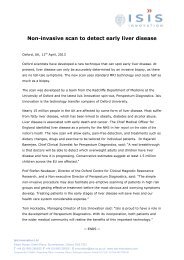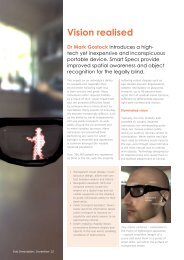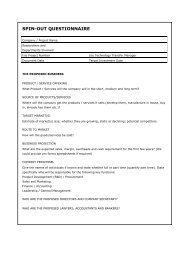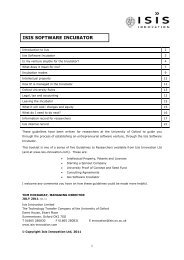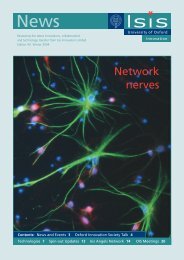CLIMATE CHALLENGE - Isis Innovation
CLIMATE CHALLENGE - Isis Innovation
CLIMATE CHALLENGE - Isis Innovation
- No tags were found...
You also want an ePaper? Increase the reach of your titles
YUMPU automatically turns print PDFs into web optimized ePapers that Google loves.
Improvement of heart by-pass operations<strong>Isis</strong> Project Number 2531Oxford researchers have developed a method ofpreventing spasm during heart by-pass operations,which significantly improves the success rate ofthese procedures.Marketing opportunityHeart by-pass operations have become a routine procedurewith around 500,000 patients or 1.5m grafts now beingundertaken per annum worldwide. Of these, around 15%of non-mammary grafts (150,000) fail due to the graftedvessel undergoing vasospasm within the first 24hrs followingsurgery. Vasospasm causes the vessel to become occludedwhich requires further treatment in the form of drug therapy,angioplasty and/or surgery. In several cases, vasospasmcauses heart attacks and, in some cases, death. Oxfordresearchers have developed a method to overcome theseproblems.The Oxford inventionThe Oxford invention comprises the novel usage of an agentand provides a method for paralysing the radial artery andpreventing or reducing vascular spasm in blood vessels.Several conventional agents, such as glyceryl trinitrate, havea broad spectrum of anti-vasospastic activity, but most haveonly a brief duration of action in vivo. The novel Oxfordinvention has a broad spectrum of anti-vasospastic responseas well as a prolonged duration of action.It will be simple and easy to use by surgeons duringcoronary by-pass grafting in theatres.The product can be a convenient, sterile kit with acontainer and the agent.Suitable concentrations and formulations of the agenthave been investigated and optimised, resulting inreduced development cost and time.It potentially provides a high-margin product, becausethe agent is relatively inexpensive.Spasms in blood vessels and the Oxford improvementSmooth muscle spasms in blood vessels used as grafts incoronary heart by-pass operations are thought to be due toa number of factors. These factors include the inflammatoryand stress responses associated with the surgery which maylead to a surge of vasoactive mediators in the post-operativeperiod. Patients undergoing cardiac surgery almost alwayshave a degree of myocardial stunning immediately aftersurgery. This leads to lower cardiac output states and poorerblood flow down the by-pass grafts. Poor blood flow downthe grafts may lead to less intrinsic nitric oxide productionand thus makes the grafts more prone to spasm.The Oxford invention uses an agent that elevates the levelof one or more cyclic nucleotides in the muscle. This agentcomprises a toxin and treating the smooth muscle with thisagent can stimulate the activation of adenylyl cyclase in thesmooth muscle cells which then catalyzes the conversionof ATP to 3’, 5’-cyclic AMP (cAMP) and pyrophosphate.The maintained production of cAMP leads to a prolongedphysiological antagonism which results in the inhibition ofsmooth muscle contraction and prevents or reduces spasms.Commercialisation opportunityThis work is the subject of a patent application, and <strong>Isis</strong>would like to talk to companies interested in developing thiscommercial opportunity.contactYa-hsin ShenProject Manager, Technology Transfer GroupT 01865 280969E ya-hsin.shen@isis.ox.ac.ukW www.isis-innovation.com10



